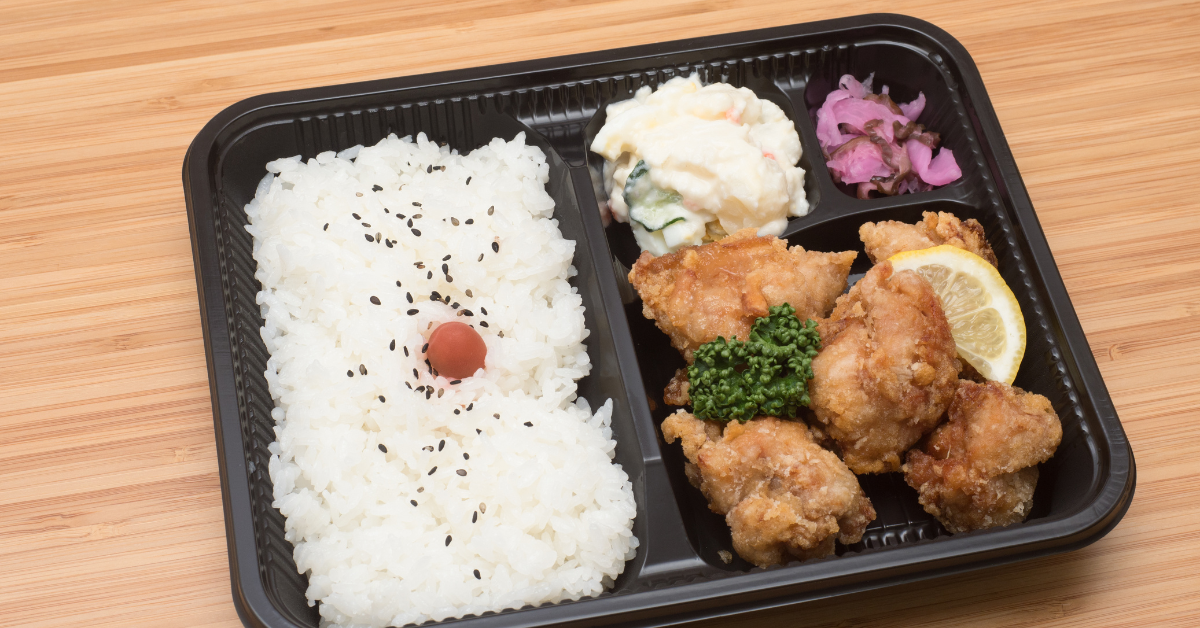Bento is one of the most iconic elements of Japanese food culture, ranging from simple homemade lunches to elaborate station bentos (ekiben) that highlight local specialties. It represents not only convenience but also family affection and cultural identity. This article explores the meaning, history, and cultural role of bento in Japan.
The Basic Meaning and Role of Bento
A bento is a meal where rice and side dishes are neatly packed into a container, making it portable. In Japan, it is the standard lunch for schoolchildren and office workers, designed with both nutrition and balance in mind.
Homemade bentos often carry love and care from the preparer, serving as more than just a meal. They also emphasize visual appeal by incorporating bright colors such as red, green, and yellow, reflecting the Japanese belief that food should satisfy both the palate and the eyes.
Additionally, bento provides convenience, allowing people to enjoy nutritious and complete meals outside the home, making it an indispensable part of modern Japanese life.
The Cultural Role of Bento in Japan
In Japan, bento carries educational and emotional significance within the family. A mother preparing bento for her child not only ensures nutrition but also expresses affection and imparts life lessons.
Bento is also essential at seasonal events and family gatherings. During cherry blossom viewing or school sports days, large bento boxes filled with diverse dishes are shared, strengthening bonds and creating a sense of community.
The careful presentation and arrangement of bento reflect Japanese aesthetics and cultural values, symbolizing mindfulness in food preparation.
The Spread of Ekiben Culture
Ekiben (station bento) first appeared in the Meiji era and expanded alongside the growth of railway travel. Its main charm lies in featuring local ingredients and regional identity.
For instance, in Hokkaido, seafood-filled bentos are popular, while in the Tohoku region, traditional local dishes are included. Kansai is known for beef-based bentos, and Kyushu highlights chicken and local specialties.
Thus, ekiben are not just meals but “regional food culture experienced through travel,” making them a vital part of Japanese tourism.
Types and Features of Bento
| Type | Characteristics | Examples |
|---|---|---|
| Homemade Bento | Cooked at home, filled with love and care | School lunches, office lunches |
| Convenience Store Bento | Easily available with a wide variety | Nori bento, makunouchi bento |
| Catered Bento | Used for events, meetings, or ceremonies, often elaborate | Memorial service bento, meeting bento |
| Ekiben (Station Bento) | Showcases regional specialties and travel culture | Beef bento, seafood bento |
| Character Bento | Designed with cartoon or animal themes, popular with children | Anime or animal-themed bentos |
Historical Background of Bento
| Era | Characteristics | Examples |
|---|---|---|
| Nara–Heian Period | The beginning of portable meals, with dried rice called hoshii | Dried rice rehydrated with water |
| Edo Period | Spread at outings and theater performances | Rice balls wrapped in bamboo leaves |
| Meiji Period | Emergence of ekiben with railway development | Makunouchi bento at Utsunomiya Station |
| Modern Times | Variety sold at convenience stores and supermarkets | Makunouchi, Western-style, health-focused bentos |
Seasonal Connection of Bento
| Season | Common Ingredients | Seasonal Bento |
|---|---|---|
| Spring | Mountain vegetables, sakura shrimp, rapeseed blossoms | Hanami (cherry blossom viewing) bento |
| Summer | Eel, edamame, cold pork dishes | Summer festival or beach outing bento |
| Autumn | Chestnuts, mushrooms, salmon | Autumn foliage-viewing bento |
| Winter | Stews, simmered dishes, New Year foods | New Year celebration bento |
The Appeal of Bento for Foreign Visitors
For foreign visitors, bento serves as a gateway to experiencing Japanese culture firsthand. The accessibility of convenience store bentos and the diversity of regional ekiben are especially attractive. Homemade bentos, carrying the warmth of family life, provide deep cultural insights.
Bento also becomes a tool for learning Japanese dining manners and customs. Through bento, visitors can experience chopstick use, seasonal eating traditions, and the value placed on not wasting food. These lessons go beyond sightseeing, offering a more profound cultural understanding.
The Modern Expansion of Bento Culture
In today’s Japan, bento extends beyond the home into every aspect of daily life. Convenience stores and supermarkets provide affordable, nutritionally balanced bentos, making them indispensable for busy workers and students.
Upscale bentos prepared by restaurants or caterers are used for events, business meetings, and ceremonies, emphasizing seasonal ingredients and presentation.
In tourist destinations, bento itself has become a cultural attraction and a way to showcase local identity, contributing to both memorable travel experiences and regional economies.
Conclusion
Bento plays a vital role in Japanese life, expressing family love, regional identity, and the joy of travel all at once. Ekiben, in particular, stands as a unique symbol of Japanese food culture and leaves a lasting impression on travelers.
To understand bento is to understand Japan itself. Through homemade meals, regional specialties, and modern conveniences, bento embodies Japanese aesthetics, values, and traditions. For foreign visitors, experiencing bento offers not just a meal but a deeper cultural journey into the heart of Japan.






